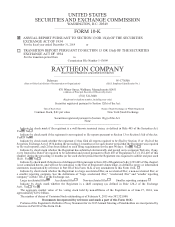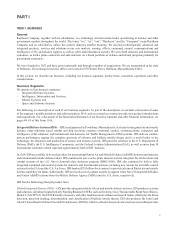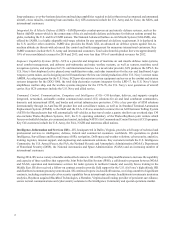Raytheon 2014 Annual Report Download - page 15
Download and view the complete annual report
Please find page 15 of the 2014 Raytheon annual report below. You can navigate through the pages in the report by either clicking on the pages listed below, or by using the keyword search tool below to find specific information within the annual report.
6
Space Systems (SS)—SS designs and manufactures space and space-qualified sensor payloads for large national programs
and develops innovative solutions for emerging intelligence, defense and civil space applications. SS provides EO/IR, radio
frequency, radar and laser space-based sensors to customers including branches of the DoD, MDA, NASA, classified customers
and international governments. Its major non-classified program is the Joint Polar Satellite System (JPSS) program providing
the Visible Infrared Imaging Radiometer Suite (VIIRS), an advanced imaging and radiometric sensor for NASA and NOAA
weather/environmental monitoring programs.
Other SAS product lines include Advanced Concepts and Technologies (ACT) and Integrated Technology Programs (ITP).
ACT conducts internal research and development for SAS and contract research and development for customers, including
the U.S. Air Force Research Laboratory (AFRL) and the Defense Advanced Research Projects Agency (DARPA), and produces
advanced products including the Boomerang sniper detection system and TransTalk, a smartphone application that
automatically translates speech into another language. ITP develops sophisticated anti-jam GPS solutions for many customers
and provides a wide range of state-of-the-art product families and engineering services in support of the DoD’s need to respond
to a dynamic threat environment.
International Subsidiaries—We conduct the operations and activities of our business segments in certain countries through
international subsidiaries, including Raytheon Systems Limited (RSL), Raytheon Australia (RA) and Raytheon Canada Limited
(RCL). RSL designs, develops, manufactures and integrates a range of high technology electronic systems and software in
the areas of sensing, effects, command & control, intelligence systems as well as cyber security for defense and other
government customers in the United Kingdom (U.K.), U.S. and around the world, and also designs and manufactures control
actuation systems, guidance electronics and silicon carbide semiconductors. Key programs include ASTOR, a world-class
strategic ground surveillance capability, and Shadow, a tactical surveillance platform (both with SAS), and Paveway™ IV,
the precision guided bomb (with MS). RA delivers integrated mission solutions and sustainment to the Australian Defence
Force. With more than 20 programs in country, RA is the mission systems integrator for the Air Warfare Destroyer project
and delivers in-service support for the Collins Class Submarine as well as the Australian Defence Air Traffic System (with
IDS), and provides aerospace-related design, integration, operations and maintenance services to its customers as well as
management of the Naval Communications Station Harold E. Holt (with IIS). RCL provides primary surveillance radar (PSR)
for air traffic management systems ranging from individual airport installations to country-wide, multiple-site, turnkey
solutions for over 40 countries, as well as coastal maritime surveillance high frequency surface wave radar (HFSWR) systems
that are operational for a number of international customers (primarily with IDS).
Sales to the U.S. Government
(In millions, except percentages) 2014 2013 2012
Sales to the U.S. Government(1) $ 16,083 $ 17,019 $ 17,861
Sales to the U.S. Government as a Percentage of Total Net Sales(1) 70% 72% 73%
Foreign military sales through the U.S. Government $ 2,962 $ 3,062 $ 3,196
Foreign military sales through the U.S. Government as a Percentage of
Total Net Sales 13% 13% 13%
(1) Excludes foreign military sales through the U.S. Government.
Our principal U.S. Government customer is the DoD; other U.S. Government customers include Intelligence Community
agencies, NASA, the FAA and the Departments of Justice, State, and Energy.
U.S. Government Contracts and Regulation
We act as a prime contractor or major subcontractor for numerous U.S. Government programs. As a result, we are subject to
extensive regulations and requirements of the U.S. Government agencies and entities that govern these programs, including
with respect to the award, administration and performance of contracts under such programs. We are also subject to certain
unique business risks associated with U.S. Government program funding and appropriations and government contracts, and
with supplying technologically-advanced, cutting edge defense-related products and services to the U.S. Government.
U.S. Government contracts generally are subject to the Federal Acquisition Regulation (FAR), which sets forth policies,
procedures and requirements for the acquisition of goods and services by the U.S. Government, department-specific regulations
that implement or supplement the FAR, such as the DoD's Defense Federal Acquisition Regulation Supplement (DFARS),
and other applicable laws and regulations. These regulations impose a broad range of requirements, many of which are unique
























